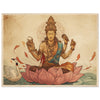
The symbols of India and their meanings
of reading
The national symbols of India and their meaning (animal, bird, emblem, fruit, flower, tree, sport)
If you like India, the Country at 447 languages, full of energy and spirituality, you will love to discover which are its national symbols and their meaning.
We return to the details about animals, emblems, birds, fruits, trees, flowers and national sports of this tremendous country.
The National symbols of India depict the image of the country and have been chosen very carefully, here is a quick list:
- The national animal, the tiger, symbolizes the power
- The national flower, the lotus, symbolizes purity
- The National Tree, Banian, symbolizes immortality
- The national bird, the peacock, symbolizes elegance
- The national fruit, mango, symbolizes the tropical climate of India

As well as our national song and our national anthem have been a source of inspiration during the fight for freedom, the national emblem of India represents four lions back to back, symbolizing the power, the courage, the pride and the confidence.
Hockey was at its peak when it was adopted as a national game of India. For more details on each of the symbols mentioned above, read the rest of this article!
The national bird of India: the peacock
The peacock is the national bird of India, commonly called the Indian peacock. He was declared National Bird of India in 1963 because it was all part of the Indian customs and culture.
The peacock is a symbol of grace and beauty. Another reason why the peacock was chosen as a national bird is its presence throughout the country, so much so that even ordinary people know this bird. In addition, no other country has had the peacock as national bird either.
The peacock has filled all these conditions and has become the national bird of India.

The National Animal of India: Bengal Tiger
The tiger is the national animal of India, it is also known as the jungle lord And it represents the richness of the Indian fauna. In addition, strength, agility and power are the fundamental aspects of tiger.
Bengal's tiger has been declared India National Animal in April 1973, with the launch of the Tiger project, to protect Tigers in India. Before that, the lion was the national animal of India.

The National Anthem of India: Jana Gana Mana
The national anthem of India is Jana Gana Mana, the Hindi version of a hymn originally composed in Bengali by Rabindranath Tagore. It was adopted as a national anthem of India on January 24, 1950.
As the Bengali song "Vande Mataram" came up against the opposition of non-Hindu segments of society, Jana Gana Mana was adopted as a national anthem of India.
The national flower of India: the lotus
The Lotus flower occupies a very important place in Indian mythology. It is the flower of the Goddess Laxmi and it symbolizes wealth, prosperity and fertility.
In addition, it grows very original in dirty water, with its long stem away above the water, wearing the flower at its top.
The lotus flower is preserved with any impurity. It symbolizes purity, success, long life and good destiny.

The National Fruit of India: Mango
The mango is the national fruit of India. The mangoes are from India and are truly Indian. Since time immemorial, mangoes are grown in India.
In ancient times too, many renowned poets have defined the delicious nature of mangoes. The great Emperor Moghol Akbar had planted about 100,000 mango trees in Lakhi Bagh, in Darbhanga.

National Song of India: The Vande Mataram
VANDE MATARAM is the national song of India. India's national song has been composed in Sanskrit by Bankimchandra Chatterjee. He inspired many freedom fighters during the fight for freedom. Initially, "Vande Mataram" was the national anthem of IndiaBut after independence, "Jana Gana Mana" was adopted as a national anthem.
This decision was made because Non-Hindu communities in India considered that the Vande Mataram was partial. These communities felt that the nation was represented by "Maa Durga" in the song.
It is therefore for this reason that it has been chosen as the national song of India and not as a national anthem.
The National Flag of India: Tricolor & Law Wheel
The national flag of India is of horizontal rectangular shape and has three colors - Dark saffron, white and green - With the center the chakra of Ashoka (Wheel of the Act).
On July 22, 1947, at a meeting of the Constituent Assembly was adopted. Also called tricolorThis flag was designed by Pingali Venkayya.

The National Sport of India: Hockey
Hockey is the national sport of India. When he was declared a national game, hockey was very popular. The game had a golden age between 1928 and 1956, when India won Six gold medals consecutive at the Olympic Games.
Hockey was considered the national game because of the talent of Hindu players, incomparable at the time. India had played 24 Olympic games and won all matches.

The National Abre of India: The Banyan
The tree Banyan represents eternal life, because of its branches that constantly extend. The unity of the country is symbolized by the enormous structure of the tree and its deep roots.
The tree is also known as Kalpavriksha, which means "tree that answers the wishes" because it has immense medicinal properties and is associated with longevity.
The Banian also houses many species of animals and birds, which represent India and its inhabitants of different races, religions and castes.

The National Emblem of India: The Lion of Ashoka
The Capital of Ashoka Lion in Sarnath is the national emblem of India. It consists of four Asian lions standing back back on a circular abacus.
The abaque has the sculptures of an elephant, a horse, a bull and a lion. They are separated by wheels. The national emblem rests on an inverted and fulfilling lotus flower.

The National River of India: Ganga
the Ginges Where Ganga is the national river of India. According to Hindus, it is the most sacred river on the planet. In fact, they perform many rituals on the banks of this river.
Indian cities that are famous for this river are Varanasi, Allahabad and Haridwar. The Ganga flows over 2510 km from mountains, plains and valleys, and it is the longest river in the country.

The national currency of India: Indian rupee
The Indian rupee (INR) is the official currency of the Republic of India. The circulation of this currency is controlled by the Reserve Bank of India. The symbol of Indian rupee is derived from the Devanagari consonant "र" (ra).
Indian rupee owes his name to a piece of money, called Rubya. She was issued for the first time by Sultan Sher Shah Suri in the 16th century, then the Mughol Empire continued.

The national heritage animal of India: the elephant
The National Heritage animal of India is the elephant. The Indian elephant is a subspecies of the Asian elephant found in Continental Asia.
It is ranked among the animals in danger by the International Union for the Conservation of Nature (IUCN). It can be seen in four different regions of the country.

The national aquatic animal of India: the dolphin
The national aquatic animal of India is the dolphin of river, also called Ganges dolphin. This mammal was once living in gang rivers, Brahmapoutre, Meghna, Kamaphuli and Sangu in India, Bangladesh and Nepal.
However, the species is no longer in its old distribution areas. The river dolphin is essentially blind and lives only in freshwater.

The National Reptile of India: Cobra
With a length of 5.6 to 5.7 m, the cobra royal is the national reptile of India. This venomous snake is in the forests of India until Southeast Asia.
It feeds on other snakes, lizards and rodents. It is cultural important since the Hindus venerates this reptile.





















